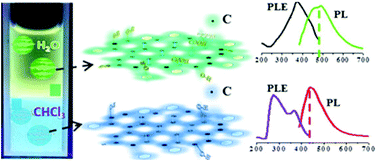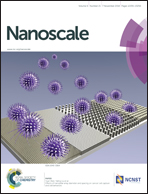Facile synthesis of analogous graphene quantum dots with sp2 hybridized carbon atom dominant structures and their photovoltaic application†
Abstract
Graphene quantum dot (GQD) is an emerging class of zero-dimensional nanocarbon material with many novel applications. It is of scientific importance to prepare GQDs with more perfect structures, that is, GQDs containing negligible oxygenous defects, for both optimizing their optical properties and helping in their photovoltaic applications. Herein, a new strategy for the facile preparation of “pristine” GQDs is reported. The method we presented is a combination of a bottom-up synthetic and a solvent-induced interface separation process, during which the target products with highly crystalline structure were selected by the organic solvent. The obtained organic soluble GQDs (O-GQDs) showed a significant difference in structure and composition compared with ordinary aqueous soluble GQDs, thus leading to a series of novel properties. Furthermore, O-GQDs were applied as electron-acceptors in a poly(3-hexylthiophene) (P3HT)-based organic photovoltaic device. The performance highlights that O-GQD has potential to be a novel electron-acceptor material due to the sp2 hybridized carbon atom dominant structure and good solubility in organic solvents.


 Please wait while we load your content...
Please wait while we load your content...